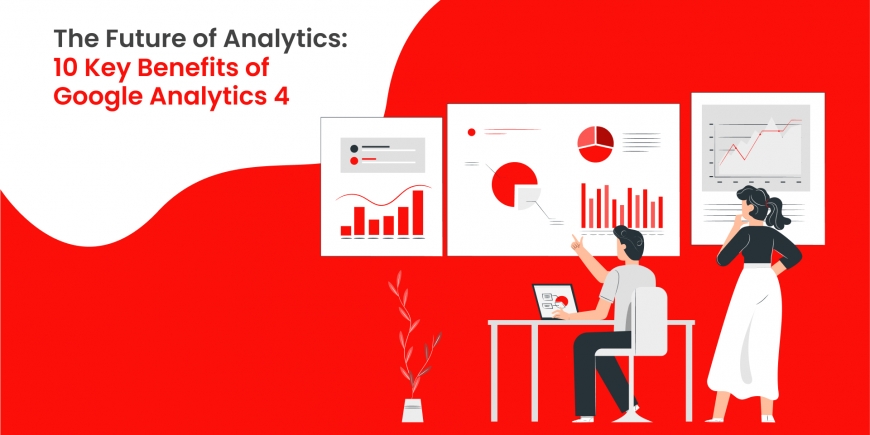The Future of Analytics: 10 Key Benefits of Google Analytics 4
Google Analytics 4 is the way of the future. If you’re not yet convinced, this article will change your mind.
You’ll learn exactly what benefits you’ll receive when you begin using GA4 and why you should stop hesitating right now.
In our previous blog, we discussed GA4 in detail. You can read about it here.
Here are 10 key advantages of GA4 that will help you plan for the future.
1. BigQuery integration
BigQuery is a data warehouse that, thanks to Google’s powerful infrastructure, can process SQL queries at extremely fast speeds. With the GA4 + BigQuery integration, you will be able to analyze terabytes of raw data, benefit from the platform’s machine-learning capabilities, and even stream data directly to BigQuery (without the need to run a load job). Of course, all of this translates to leveraging any raw data you can get your hands on.
BigQuery, which was previously only available to GA360 (paying) users, is now available to all GA4 users for free. Although the free tier has quotas and limits on the amount of data you can store and query, there is already so much you can do with the monthly free data allowance. You get 10GB of free storage and free query data processing up to 1 TB.
2. Unsampled data
The amount of data that can be collected with Universal Analytics (UA) is limited to 10 million hits per property per month. And a lot of sampling can happen when processing data, such as when you use an advanced segment and have more than 500,000 sessions.
In GA4 standard reports, sampling has been removed, and the amount of data that can be collected is now unlimited. Having access to unsampled data is important because it ensures that your decisions are based on reliable data. While sampling can be useful when working with segments and secondary dimensions, relying on sampled data puts you at risk of working with incomplete information.
3. Extended segmentation possibilities
GA4 audiences enable more targeted segments for marketing campaigns. You can now create segments based on events, which was not previously possible, and add the concept of time if desired.
This means you can now concentrate on users and their interactions rather than unnecessary device or platform differentiation. And by incorporating the concept of time into your segment, you can do so much more, such as analyze the amount of time users spend between steps in your sales funnel.
It’s also worth noting that any published audience will be shared with Google Ads automatically. When you run a campaign, the exact audience you want to reach will be right there.
4. Engagement metrics
Instead of providing the bounce rate, or the percentage of users who leave a page without engaging, GA4 provides positive data on user engagement. When a session lasts at least 10 seconds, has at least one conversion event, or involves at least two page views, it is considered engaged.
Scroll, site search, video engagement, and file downloads are examples of enhanced measurement events that show you exactly how users interact with your site and content. All of these will give you a sense of whether your blog post or eBook landing page is engaging enough for your audience to keep reading or sign up for a download. Enabling this type of tracking in UA necessitates a significant amount of custom coding.
5. Cross-platform tracking
Prior to GA4, website, and app engagement were always measured separately. It’s easy to see why Google Analytics 4 was dubbed Google Analytics App+Web while it was still in beta.
GA4 now combines Firebase Analytics data from apps and Google Analytics data from websites into a single property. This means that getting a complete picture of engagement across your platforms no longer has to be a time-consuming and manual process.
This brings us to the next major advantage of GA4.

6. Complete user journey:
Life Cycle is a new section in GA4 that includes reports on Acquisition, Engagement, Monetization, and Retention. These categories, as you may have noticed, correspond to the customer journey.
Zooming in on customer behavior and gaining insights into where marketers should focus more attention or change their strategy is now easier than ever. The acquisition and engagement reports may reveal which of your awareness campaigns or paid advertisements, for example, are effective and which types of content provide the most value to your users—or the opposite.
Of course, you want to know how much of your revenue targets you’re meeting and whether you’re doing enough to build customer loyalty. The monetization and retention reports provide information on revenue and customer retention.
The ability of GA4 to connect the user journey stems from its user-centric analytics and event-driven data model. So, if a user first visits your website on their desktop computer, then browses your products on their smartphone, and finally purchases through your app, GA4 provides the tools to track all of these events and provide you with a comprehensive view of the customer journey. That is one key advantage of GA4 that marketers can fully exploit.
7. More intelligent tracking
With governments and regulatory organizations enacting new and stricter privacy laws, it is becoming increasingly difficult to track users using cookies. We also know that current tracking methods rely heavily on cookies.
Yet, Google assures us:
“Because the technology landscape continues to evolve, the new Analytics is designed to adapt to a future with or without cookies or identifiers. It employs a flexible approach to measurement and, in the future, will incorporate modeling to fill in the gaps where data may be lacking. This means you can rely on Google Analytics to help you measure your marketing results and meet customer needs now, as you navigate the recovery and face future uncertainty.”
Vidhya Srinivasan, Vice President, Engineering, Google Ads, Google
GA4 implements more intelligent tracking that is not reliant on cookies by utilizing AI and machine learning.
8. Advanced analysis
Previously available only to GA360 users, a suite of tools for performing advanced analysis and creating ad hoc funnels is now free in GA4.
- More advanced funnel customization options enable you to create very specific funnels.
- Path analysis allows you to identify the most common user paths (e.g., from reading an article to signing up for the newsletter).
- Heat maps give your analysis a new dimension.
- The segment overlap report displays the connections between the segments you’re interested in.
- The user explorer report allows you to take a closer look at specific user segments that you believe are most relevant to your analysis.
9. Predictive metrics
What would you do if you could predict which users are likely to buy in the coming month and how much revenue will be generated by their purchase conversions?
Exactly. You persuade them to buy!
GA4 introduces three predictive metrics that allow you to do just that:
- Purchase probability – the likelihood that a user who has been active in the previous 28 days will make a purchase in the next 7 days.
- Churn probability – the likelihood that a user who was active in the previous 7 days will be inactive in the next 7 days.
- Revenue prediction – the expected revenue from a user who has been active in the last 28 days over the next 28 days.
These metrics can be used to create predictive audiences, which can then be used to create highly targeted campaigns during critical periods in terms of conversion likelihood.
10. Better ROI
You can now better plan your campaigns and target the relevant audience within the timeframe that matters because you have highly insightful analytics reports to work with.
If you play your cards correctly, you should be well on your way to creating successful marketing campaigns that meet objectives, resulting in a higher ROI on ad spend.
And there you have it: the ten most important benefits of GA4 that you are missing out on if you choose to stay in your comfort zone.
While we don’t recommend abandoning your existing Universal Analytics property yet, you should definitely begin using Google Analytics 4 right away. GA4 is jam-packed with incredible new features that will help you plan for the future of your analytics strategy.
However, how much GA4 can do is limited by the amount of data it has to work with. And you should be aware that gathering enough data to conduct any significant analysis takes time. The sooner you begin, the sooner you will be able to collect critical data and become acquainted with the changes brought about by GA4.
You’re not sure you’ll be able to implement GA4 yet? Our experts are eager to assist you in achieving your Analytics objectives, no matter where you are on your journey. Please contact us right away!
731 total views
There are no comments



